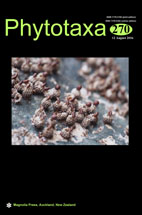Abstract
The aim of this study was to provide a molecular perspective on the taxonomy of Warburgia across most of its range, including South Africa, Zimbabwe, Mozambique, Tanzania, Kenya and Uganda. An accurate taxonomic treatment of Warburgia is important for the construction of sound conservation strategy, as a number of the proposed species and subspecies are regarded as endangered or critically endangered. Analyses based on 702 nucleotides of the plastid trnL-F region, 532 nucleotides of the nuclear ribosomal (nr) ITS region and eight polymorphic ISSR primer pairs yielded congruent results. Molecular clock analyses yielded a crown age of 45.5 (31.2–64.9) MY for Canellaceae. The crown age of Warburgia was dated to the early Miocene, 19.6 (11.4–29.1) MYA, with diversification into moderately supported lineages in the later Miocene, 11.6 (6.0–19.0) and 7.2 (3.2–12.7) MYA. Warburgia samples formed three major clades: a widespread clade covering most of the range, a northeast clade from parts of Kenya and Tanzania, and a stuhlmannii clade formed by GenBank samples accessioned as W. stuhlmannii. There was some ambiguity in the association between these clades and morphologically defined Warburgia species. We found no evidence to support W. elongata as a genetically distinct species. Genetic diversity in Warburgia was low in both DNA markers. We propose inclusion of these haplotypes in conservation strategies. Further molecular analyses based on a greater number of more variable DNA regions and an expanded sample set with more extensive geographical coverage are required to clarify whether the above groupings warrant status as genetic or phylogenetic species and to refine conservation strategies so as to include greater genetic variability.

